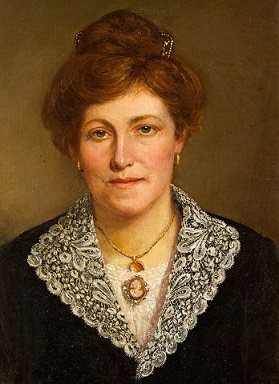George F. Harris - ArtistWalking through Randwick General Cemetery at South Coogee many years ago I came across an interesting headstone. I was intrigued by the carving of an artist's palette and paint brushes surmounting the headstone. The headstone read: In memory of George F. Harris [Artist] who died on 14th June 1924 aged 67 years. "He still lives on in his work." Erected by his fond wife and children. And Rosetta his wife, aged 71 re-united with him 28th October 1946. There is no death, what seems so is transition. I was a librarian with access to many art encyclopaedias and indexes, so if he still lived on in his work, as his headstone suggested, I thought it would be easy to discover more about him. I could find no mention of Harris. If his descendants were looking for some sort of immortality for him through his work, then Mr Harris might have passed, forgotten and remained an elusive mystery. However, I recently came across my notes about George Harris, and now being able to do an Internet search - George F. Harris, suddenly came back to life, figuratively speaking. Thanks to online art auction records and other online sources, I could now build a picture of George F. Harris.
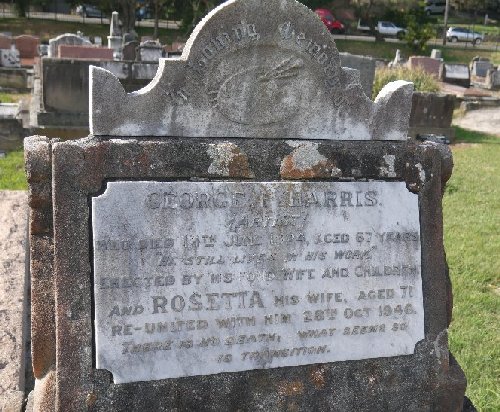 George F. Harris' grave at Randwick General Cemetery, South Coogee
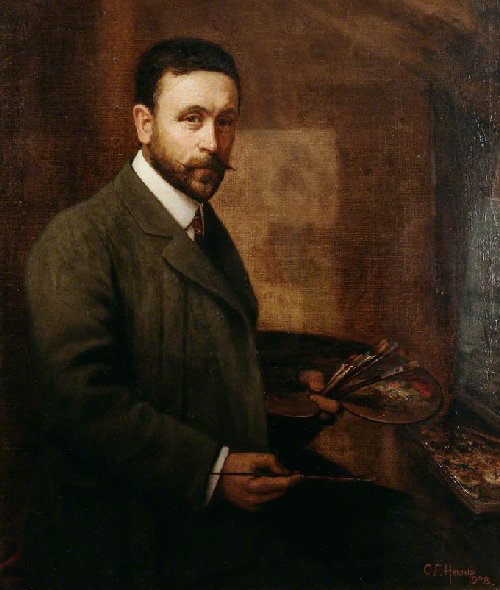 Self Portrait, George Frederick Harris, 1908
Early Life in Wales George Harris lived with his family at Merthyr Tydfil, a town 37 km north of Cardiff Wales, for most of his life, before emigrating to Australia in 1920. In Wales he established himself as a relatively successful painter, portraitist and photographer. He became chairman and secretary of the South Wales Art Society. He was successful enough for the Merthyr Tydfil Museum & Art Gallery to feel it worthwhile to hold a collection of his portraits. Harris married Jemima Reid Harris, nee Bowmen in Chelmsford, Essex, UK in August 1882. They had two children Claude Harris (born 1884) and Ethel Harris (born 1884). After Harris divorced Jemima, he married to Rosetta Elizabeth Harris, nee Lucas in 1901. Rosetta was originally the nanny to George's children from his first marriage, before the couple eloped. They in turn had nine children:
George F. Harris' two elder sons (Claude and Cromwell) had immigrated to Perth Western Australia, and Harris and his remaining family followed in 1920. They settled briefly in Perth, before finally settling in Sydney, either in 1920, or by some accounts in 1921.
Settles in Sydney Harris also relied on photography to supplement his income. He did work for the Monte Luke photograph studio as well. Harris bought a weahterboard house for his family at nearby Bell Street, Maroubra (named "Thanet") for £700. This is on the high side of northern Maroubra and looks down on Maroubra Bay. His daughter Pixie produced a number of views of Maroubra that seem to be from this vantage point. Harris, long a keen and prominent Mason, joined the Maroubra Masonic Club. Harris also painted still life, including one piece of a vase of flowers called "Pride of Australia" which he entered into the Royal Art Society's 1922 exhibition. The following year's exhibition he had another still life titled In The Larder", a collodion of eggs and other articles lit by a candle. The same exhibition included two line drawings by his daughter, described then as "Miss Pixie Harris". A landscape that features a sailing boat and a ship near Fort Denison in Sydney Harbour was acquired by the State Library of New South Wales which has been reproduced as a favoured print which can be purchased from the Library.
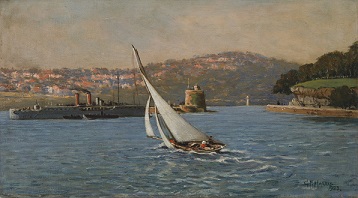 Painting of Fort Denison on Sydney Harbour by George F. Harris
Buried at South Coogee So, that explains how George F. Harris' grave with its remarkable headstone came to be in South Coogee - his headstone hoping for immortality. Harris had at least two notable descendants.
Rolf Harris
Pixie O'Harris She was educated at Maroubra Bay Primary School. According to her autobiograpy, she was the first "surfer girl" at Maroubra Beach to the disdain or her father who forbade her to be phographed in the surf or on the beach. Pixie O'Harris became a successful and much loved Sydney artist, newspaper, magazine and book illustrator, author, broadcaster, caricaturist and cartoonist, designer of book plates, sheet music covers, stationery, and children's hospital ward fairy-style mural painter. She was awarded a number of commissions to paint fairytale themed murals in childrens hospitals across New South Wales including at Bulli Hospital, Manning Valley Hospital and the Prince of Wales Hospital. She was often aided by her brother Olaf Harris. Pixie married Bruce Pratt (1902 - 1989), later the editor of the Australian Encyclopedia, in July 1928 and they lived at Watsons Bay where she kept her studio. They were often referred to in the press as Mr Bruce and Mrs Rona Pratt. The pair were awarded Bronze Medals for bravery by the Royal Humane and Shipwreck Society in 1932 for diving into Sydney Harbour from a ferry in January that year to rescue a drowning man who had fallen overboard from another ferry and been in the water for two hours. When the man's plight became known to ferry passengers, Pixie handed her 10 month old daughter to another passenger, and she and her husband dived into the water to support the floundering man. Predeceased by her husband and survived by her three daughters, she died on 17 November 1991 at Lindfield, Sydney, and was cremated. As a prolific author and illustrator, Pixie Harris had become a much loved figure and household name in Australia.
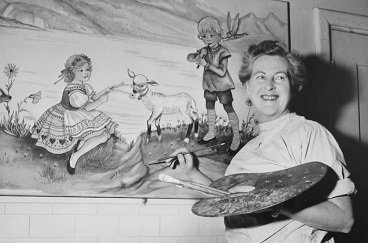 A portrait of Pixie O'Harris c.1951 : National Portrait Gallery, Canberra.
Olaf Harris In 1924, Olaf joined the commercial art establishment of Crisp Brothers, where he worked for sixteen years, excelling both as an artist and designer. He also attended Julian Ashton’s art school where he likely became acquainted with many budding artists. Olaf enjoyed painting for pleasure, and in 1943, his portrait of his sister, Pixie O’Harris, was a finalist in the Archibald Prize. This notable work depicted Pixie with one of the fairy characters that made her popular among Australian readers. He was often referred to in the press as Olaf O'Harris. In 1946, Olaf partnered with Robert Coates to form the successful company O’Harris Advertising. Olaf collaborated with Pixie on several mural projects for children's hospital wards, clinics, and nurseries. One significant project was commissioned by the Manning Base Hospital Ladies Auxiliary in 1957, where they created 7 of the 25 paintings to brighten the hospital environment. These works have since been rediscovered, restored, and exhibited.
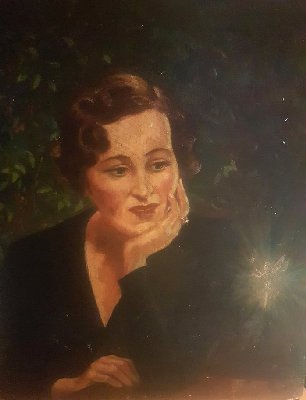
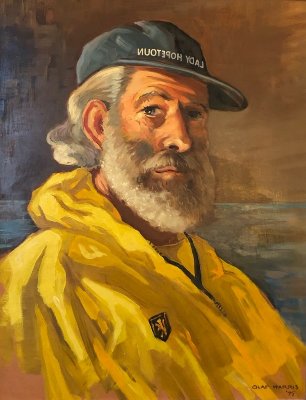 (left) Pixie O'Harris portrait in 1943 Archibald Prize entry by Olaf Harris and (right) his self portrait The legacy of George F. Harris and his family is deeply woven into the fabric of Australian art history. Through his portraits, still lifes, and the cherished works of his children, especially Pixie O'Harris and Olaf Harris, the Harris family's contributions continue to be celebrated and appreciated and leave a mark on the cultural heritage of Australia, Their works ensure that the memory of George F. Harris lives on, as his gravestone poignantly reminds us, through his work and that of his descendants.
References
Copyright © Coogee Media All rights reserved
| CONTACT US | ABOUT US |
|
